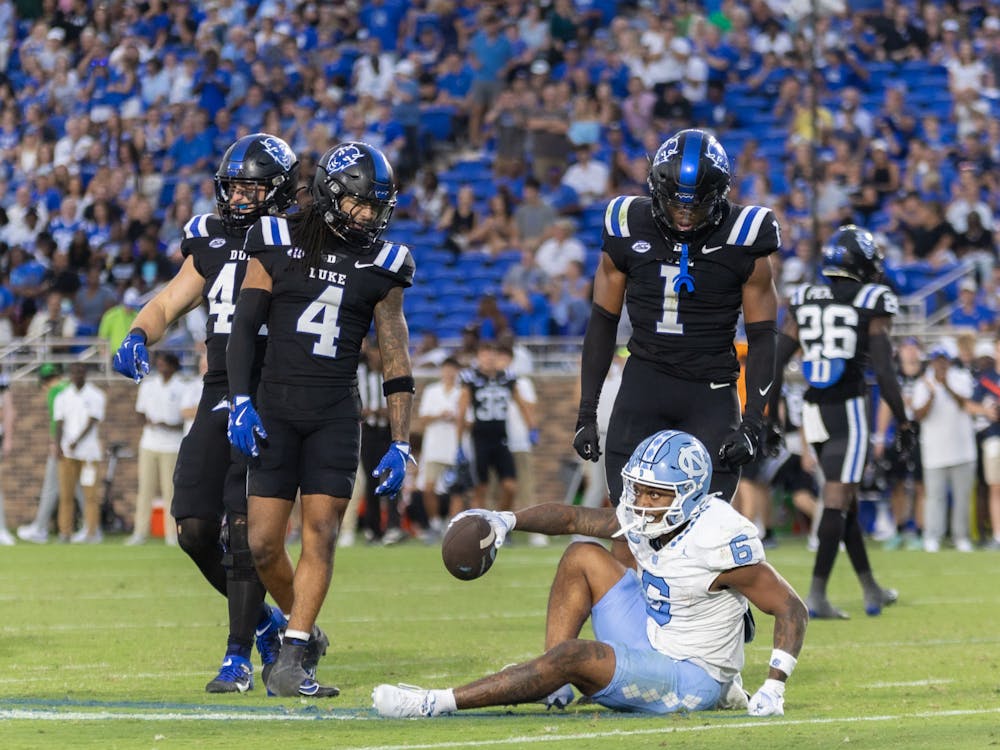Duke had one of its biggest defensive highlights of the season in the middle of the first quarter against Northwestern. Deep in his own territory and with pressure in his face, quarterback Mike Wright threw to wide receiver Frank Covey IV. Junior safety Terry Moore rushed in to make the interception, toe-tapping on the sideline to keep the play alive. The Blue Devils scored on their ensuing offensive drive, making Moore’s pick critical in a game Duke only won by six points.
As good as it was, this play was not a fluke. Five games into the 2024 season, Moore is having not only one of the best seasons by a safety in college football, but arguably one of the best individual Duke seasons of all-time.
For a program that only periodically produces nationally-acclaimed talent, this statement may sound hard to believe. The last Blue Devil to earn All-American honors was safety Jeremy Cash in 2015, who also won the ACC Defensive Player of the Year trophy that season. However, it would not be hyperbole to say that Moore, a former running back, is posting a better season thus far than Cash did. So, just how good has Moore been in 2024?
According to Pro Football Focus (PFF), Moore has been targeted 16 times in the 2024 season by opposing quarterbacks. On those targets, the junior has allowed eight completions for just 49 yards and one touchdown; he has recorded two interceptions. If these statistics were for a quarterback, that player would post an extremely low 37.8 passer rating. This metric — referred to as passer rating allowed — underscores Moore’s brilliance in coverage. Figure 1 compares this statistic to PFF’s coverage grade, a metric grading a defender’s performance in coverage from 1-100. Placement in the top-left region corresponds to a better coverage player, and a minimum of 110 snaps in coverage were needed to qualify.
Figure 1
As shown, Moore is even outpacing Colorado cornerback and Heisman candidate Travis Hunter, who has faced a similar number of targets (19) and has allowed more than twice as many yards (100). Moore’s 89.8 grade in coverage ranks second out of all FBS safeties, just behind Iowa’s Jermari Harris. Additionally, Moore is by far the best coverage defender for the Blue Devils, as safety Jaylen Stinson is a distant second with a 73.4 grade.
Comparing Moore with Cash’s All-American season in 2015, the former’s 37.8 passer rating allowed is significantly better than Cash’s 102.5. Moore has recorded two interceptions through Duke’s five games, while Cash had none in 2015. Cash — who had three sacks in 2015 — was better at getting after the quarterback than Moore, but this is due to playstyle and scheme, as Moore plays almost exclusively as a coverage safety.
There are two primary types of coverage. Man-to-man is when defenders individually follow opposing receivers, and in zone, they are assigned to cover an area of the field. The Blue Devils run zone more often than man, as Moore has played 55 snaps in man and 90 in zone. Despite these differences in technique, the junior safety has excelled in both according to PFF, as Figure 2 displays.
Figure 2
Although Moore has been excellent this season, he has struggled slightly with consistency. In Week 5 against North Carolina, Moore posted a mediocre 61.8 coverage grade and missed four tackles. However, he had a tackle for loss on running back Omarion Hampton early in the fourth quarter to help give the ball back to the Blue Devils, showcasing his versatility.
Despite his clutch tackle against Hampton, stopping the run has not been Moore’s strong suit in 2024. Run-stop percentage is a PFF-created statistic that measures how often a player will “stop” the opposing offense by tackling the runner. A stop is defined as a “loss” for the offense. Figure 3 compares FBS safeties’ run-stop percentage versus their PFF grade against the run, with a minimum of 90 run-defense snaps needed to qualify.
Figure 3
Overall, run defense is generally not as integral to safety play as pass coverage is, at least to PFF. A safety's pass-coverage grade is far more correlated to his overall grade than his grade in run coverage. In other words, Moore’s dominance against opposing quarterbacks has made up for his lack of success against the run so far.
Still, Moore struggled against Hampton, posting a 58 run-defense grade in Duke’s victory against North Carolina. Additionally, the Blue Devils are set to face dominant running backs like SMU’s Brashard Smith, as well as dual-threat signal-callers including Georgia Tech’s Haynes King and Miami’s Cam Ward.
Moore and the Blue Devils will face an important test as an underdog against King and Georgia Tech Saturday. However, if the Washington, N.C., native plays up to his early-season dominance, Duke may pull off the upset and could even shock the ACC in the second half of the season.
Get The Chronicle straight to your inbox
Sign up for our weekly newsletter. Cancel at any time.

